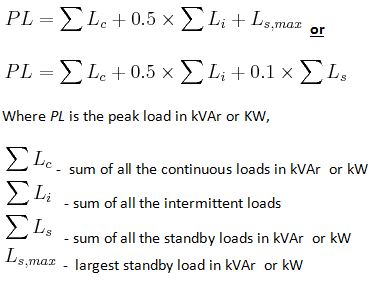
Let your fellow member A.N tell you about it and don’t hesitate to send us a mail if you want to be published in the blog too!
The load schedule, which should be done at the installation design stage, is determined through calculations. In some cases, this should be done with the future in mind, especially if there are foreseen additional loads.
Preparing the schedule requires a list all the equipment or loads together and all associated ratings and parameters.
Typical steps in preparing load schedule
Below are some of the typical steps that may be used when preparing the load schedule for an industrial plant for the first time.
- Create a list of all expected loads in the installation or facility. Specify whether they are process or non process loads.
- Get the electrical characteristics for each of the loads, including voltage, current, nominal ratings, absorbed ratings, efficiency, power factors, etc
- Classify each equipment by load duty, load criticality and switchboard location
- Calculate expected consumed load for each load
- Calculate the operating, peak and design loads for each switchboard and then for the overall installation.

A sample typical load summary | image: www.slideshare.net/wiwitpur/load-list-calculation
Calculating the operating load, peak load and design load
Once you have the information, calculate the expected consumed load, operating load, peak and design load.
Consumed load
Consumed load: this is the amount of power equipment is expected to consume. The active and reactive power is calculated from the formula:
This can be done according to the load duty to find out the individual and total consumed load during intermittent, standby and continuous load.
Operating load
Operating load refers to the expected power consumption during the normal operations and calculated from:
Peak load
This is the expected maximum load that may occur during the normal operations. It usually lasts for a short duration, such as when standby loads are operated during testing of the systems, changing over machines or any other scenario that puts more stress on the installation.
Design load
The design load is what is used for electrical studies, equipment sizing and calculated from whichever is the larger of the following
The design load is intentionally made larger to accommodate errors that may have occurred during load estimation, or due to additional unforeseen load which may not have been included during design phase. The design load should also be higher to cater for future load growth. This results to over-sized equipment to take care of the extra load. The peak load may sometimes be used for design purposes; in such as case, the design load is calculated from DL = 1.2 X PL.
A typical summary of loads is as shown in the table below:
Benefits of a load schedule
- Gives a good estimate of electrical load during the normal and the peak loading
- Allows the design to include provisions for additional load or at least advise building owners of requirements to accommodate any extra load or expansion
- By understanding the load, and when peak consumption is likely to occur, it is possible to implement an informed power management scheme that ensures that the load is average most of the time, and eliminate cases of alternating between very low and very high peak consumption periods.
- With proper management, it not only brings down the electricity bill charged at the peak times, but also benefits the generating company who now can generate less energy.
- It enables the design to cater for future loads.
- The estimate helps in selecting the collect size of conductors, conduits and control and protection gear.
Load Schedules for different operating schedules
It may be necessary to get the operating, peak and design loads for each circuit on the switchboard. The individual circuits are then added together to give the overall load for the system. Different load schedules may be prepared to find out the operating and peak as well as design loads for different classes of loads such as for the process and non-process loads, when in standby, intermittent or continuous operation. Further these may need to be prepared for situations when all critical loads are operating at peak.
Several other schemes may be evaluated under different conditions to determine the amount of power required and associated installation requirements. In particular, determining the peak critical load may be necessary in a medical facility, airport or any other sensitive installations. Determining this helps in selecting the proper backup generator or UPS.
A load schedule for different operating scenarios will show when peak consumption occurs and provide an opportunity to find out if all the high loads must operate at this time. Analyzing the process and non process loads can help design a power management scheme where only what is critical for the efficient operation is powered on during peak tariffs. The loads which can be scheduled to run during the off-peak tariff or when the total load is not as high can then be configured to do so as long as they do not impact on the production. This helps in spreading out the energy use and saving on the electricity bills.
Conclusion
Preparing a load schedule helps in determining the amount of power required for an installation. The load schedule helps electrical engineers to properly size conductors, conduits and protection systems.
In addition, it helps designers to properly size the power backup generators or other alternative power sources.
Thanks for reading,
A.N.
What’s your experience in the preparation and the benefits of preparing a load schedule? Write a comment below.





Beside having an accesible inventory control, it is Useful for load /phase balancing applications.
Can anyone advise me about reference IEC standard or IEEE standard for the same
I also request the reference IEC or IEEE standard
its actually helping i was confused when i glanced the text book,
pls some one should help with ieee regulations
Why 1.39 is muktiplied to total power load to get the result in amps